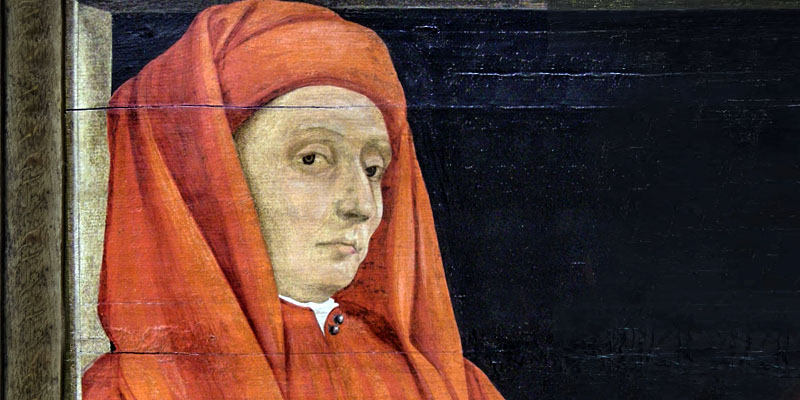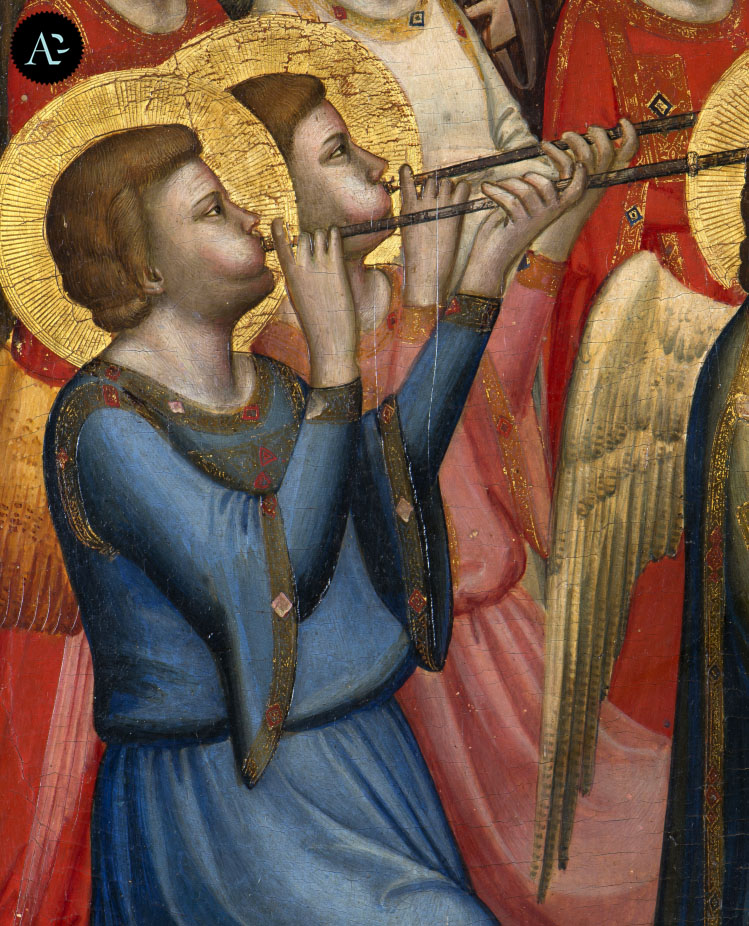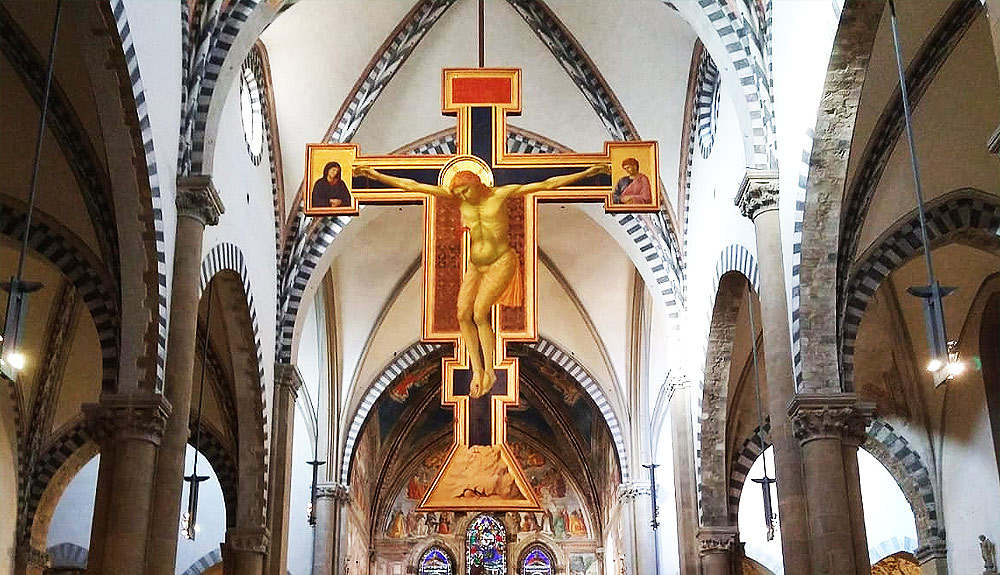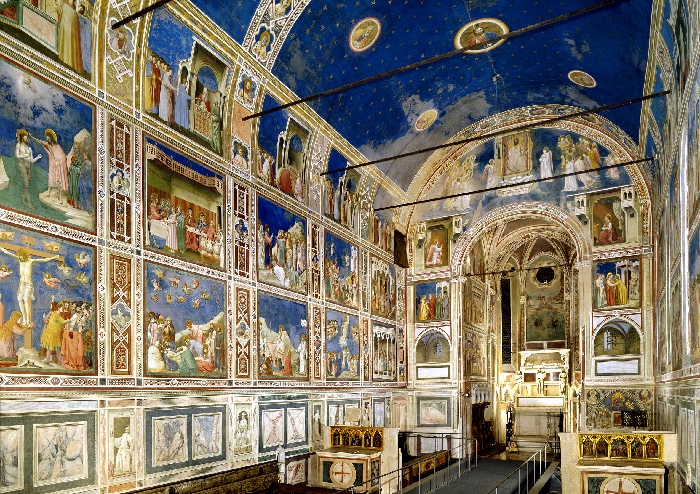
In this blog, I have only dealt with Giotto’s life and works on the occasion of the major exhibition Giotto, l’Italia, which took place in Milan in 2015 and with which I had collaborated for the promotional and digital content creation part. The time has come to delve into Giotto’s life and works with this post in which I will take you on a discovery of one of the most extraordinary and revolutionary painters in the history of art.
Giotto is a genius of Renaissance art who left an indelible mark on the artistic landscape, changing the face of medieval painting forever. So here is my complete guide to better appreciate his works during a visit to the city of Florence and beyond.
Life and Works of Giotto and the Revolution of Medieval Art

Giotto di Bondone, known simply as Giotto, was one of the most famous painters in the history of art. Born around 1267, probably in Florence or in the Mugello hills, he revolutionised the way of painting of his time. He abandoned the austerity and rigour of Byzantine painting, paving the way for an art that was more natural and faithful to reality. His extraordinary talent and the legends surrounding him have made him an icon of medieval art.
THE ORIGINS AND LIFE OF GIOTTO
Little is known about Giotto’s exact origins, but what is certain is that his artistic talent led him to become one of the greatest painters of his time. Growing up perhaps in Florence or in the hills of Mugello, Giotto showed an incredible flair for art from an early age. His training presumably took place in the workshop of Cimabue, a renowned painter and master of the time. It is possible that his artistic career started right here, amidst the colours and nuances that the masters of the time experimented with.
Despite the legends surrounding his ability to draw a perfect circle freehand, it is undeniable that during his lifetime Giotto acquired an extraordinary mastery of the artistic techniques of the time. His ability to capture the expressiveness and depth of human emotion in his paintings became one of the hallmarks of his style.
Towards the end of the 13th century, Giotto was already an established artist and his reputation grew further when he was commissioned to decorate the frescoes of the Scrovegni Chapel in Padua. This cycle of frescoes would become one of his most famous works and a jewel of Italian art, a tangible testimony to Giotto’s mastery and his ability to convey emotions and complex narratives through pictorial language.
It is thought that Giotto also had the opportunity to travel to Rome to work on works that no longer exist. This trip would have further enriched his artistic training and knowledge, giving him the opportunity to come into contact with the artistic styles and trends that characterised the capital.
The Scrovegni Chapel, along with other important commissions, granted Giotto a prestigious position and established him as one of the leading artists of his time. His ability to bring figures to life and create an unprecedented sense of spatiality in his paintings profoundly influenced painters of subsequent generations and laid the foundations for art in the 15th century.
Giotto’s greatness lies not only in his technical skill and artistic innovation, but also in the humanity he infused into his subjects. Giotto’s works represent a bridge between the spiritual and real worlds, capturing the essence of human experience with unparalleled mastery.

Giotto, Crocifisso di Santa Maria Novella
GIOTTO’S WORKS AND THE ART REVOLUTION
Giotto left an indelible mark with his masterpieces. One of his most important early works was the ‘Crucifix of Santa Maria Novella’, preserved in the Church of Santa Maria Novella in Florence, in which he introduced a realistic representation of Christ. The rigid and schematic figures gave way to a more vivid and truthful humanity.
The Scrovegni Chapel in Padua is another must-see work, where Giotto painted a breathtaking cycle of frescoes and the first Last Judgement.
In these works Giotto conveyed emotions and feelings in a way never seen before, creating a realistic spatial depth.
Giotto left an extraordinary legacy through his masterpieces, which revolutionised the world of medieval art. In addition to the works already mentioned, there are other important works that exemplify the genius and innovation of this visionary artist.
One of his most famous masterpieces is undoubtedly the ‘Polittico di Bologna’, now in the Pinacoteca Nazionale in Bologna. This extraordinary work of art, characterised by a strong spirituality and the masterful use of colour and light, shows Giotto’s ability to communicate profound emotions through the faces of his subjects.
Another outstanding work is the ‘Rimini Crucifix’ in the Malatesta Temple in Rimini. This painted cross presents a figure of Christ of moving realism, characterised by human suffering that is reflected in his facial features and body posture. Giotto succeeded in conveying a sense of piety and devotion that engages visitors, leaving a lasting impression in the hearts of those who admire his work.
Equally significant are the frescoes of the ‘Bardi Chapel’ in Santa Croce, Florence. In this cycle of paintings, Giotto demonstrated an ever-increasing mastery of perspective and spatiality, creating narrative scenes of extraordinary beauty. The human figures are drawn with unprecedented realism, making the emotions of the characters tangible for the observer.
Giotto’s genius was also expressed in his ability to experiment with new artistic solutions. For example, in the ‘Madonna di Ognissanti’ now housed in the Uffizi in Florence, he introduced a sculpted marble frame seen in foreshortening, an original and innovative solution for the time. This detail testifies to his interest in architecture and sculpture, giving his works a sense of three-dimensionality and depth never seen before.
Giotto’s life and works caused a real revolution in Medieval Art as his ability to represent reality authentically, the intense humanity of his subjects and his mastery of the creation of space and light opened up new horizons for art, leaving an indelible mark on human history.
Admiring Giotto’s works today means getting in touch with the soul of medieval art and perceiving the epochal transformation that led to the Renaissance. Every detail, every brushstroke, transports us into a world of emotions, spirituality and the search for absolute beauty. Giotto di Bondone is undoubtedly one of the pillars of universal art, an artist who was able to redefine the boundaries of human expression through painting, leaving an invaluable legacy for generations to come.
WHERE TO ADMIRE GIOTTO’S WORKS
If you want to see Florence, you cannot miss the chance to admire Giotto’s masterpieces. At the basilica of Santa Maria Novella, you can see the ‘Crucifix of Santa Maria Novella’ while at the Uffizi you can take a closer look at the ‘Madonna di Ognissanti’ and the ‘Badia Polyptych’. At Santa Croce, look at the frescoes in the Bardi and Peruzzi Chapels. The Horne Museum also houses an impressive ‘Santo Stefano’ by Giotto.
However, to complete your journey of discovery of Giotto, you cannot ignore the Basilica of San Francesco in Assisi. Here you can admire the frescoes of the Lower Basilica, attributed to Giotto. This is a must-see destination to fully understand the genius of this extraordinary artist.

Cappella degli Scrovegni a Padova
Giotto di Bondone was an extraordinary painter, a fundamental figure in the history of medieval art and also of the Renaissance. His works have influenced generations of artists and his revolutionary style continues to enchant visitors from all over the world.
If you are passionate about art and looking for inspiration, a trip to discover Giotto will be an unforgettable experience. You will discover the humanity and innovation behind the masterpieces of this great master.


Grazie per questa pubblicazione